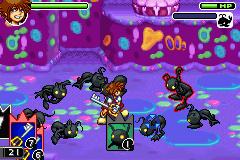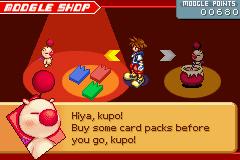Kingdom Hearts: Chain of Memories Review
When Kingdom Hearts: Chain of Memories was announced, it seemed to be a bit of a joke. Everyone knew that Kingdom Hearts was to have a different sequel, Kingdom Hearts II, on the same platform as the original. Typically, there will be Series Name, then Series Name II, Series Name III and forever up to Final Fantasy XII, with no room for a Kingdom Hearts 1.5. So where does that leave Chain of Memories?
It has the same protagonist, same main characters, same worlds, same monsters, and a similar premise to the original Kingdom Hearts. It takes place immediately after the first game, under the assumption that all the characters have lost their memories, and are trying to recover them (by playing through all the same worlds all over again).
At first, I thought it was essentially Kingdom Hearts pocket-sized, so that I might carry it around in my GBA and play it on the go. But the battle system changes gameplay entirely.
Kingdom Hearts was a Square-Enix RPG that worked well in real time. The graphics flowed nicely, there were no transitions into battle mode, and if it was turn-based, it would have felt too much like Final Fantasy with Mickey Mouse. Chain of Memories keeps the real time system, but adds in the battle transitions.

There are other games that also have the real time wandering with monsters meets spinning official battle sequence, so think the Xenosaga series. This provides the obvious advantage of steering clear of monsters and simply refusing to touch them, which Chain of Memories perfects by letting you actually choose the speed and type of monsters you want in the next room.
Once you actually get into a battle, the system is shockingly different, if you're expecting a remake of Kingdom Hearts. Sora is now some sort of weird Cardmaster, who builds decks and casts spells, summons, and attacks with them.
Several cards are visible at once, and after each card is used, it is discarded, and the next card of the deck takes its place. Once you've gone through the entire deck, you can take a moment to reshuffle, but it leaves you vulnerable to attack.
However, unlike most card games, Chain of Memories is hardly a strategy game. Since even the card battles are in real time, you hardly have a split second to think about your moves before you make them. If you stock a deck full of keyblades, repeatedly hitting 'A' will get you a very Kingdom Hearts feel, and it's hardly different from normal battling, except that you run out of hits and have to reload. Also, all your enemies attack using cards.

Since each card is numbered (0-9), the person with the larger card can 'break' or stop the attack of the other. 0 is both the largest and the smallest card; it can break any other card, but can also be broken by any card.
Card breaking is an extremely useful strategy for obliterating enemy attacks if you have the patience for it, but button mashing is still an option. Card combos can also be done, for added strength in attacks. Instead of allies fighting alongside you, you can summon them randomly if their cards appear during battle. They will do one attack, and then dash off.
Card decks are something you'll either love or hate, but they certainly add a challenge to the game without being obnoxious. In Kingdom Hearts, the battle system control was difficult because of its three-dimensional nature and its creative multiple story areas. In Chain of Memories, battle system control is difficult because of its limited fighting space, as battle sequences place you in closed areas. Cards add an edge to an otherwise two-dimensional game, and can be found, rewarded, or bought at Moogle shops.
Of course, the most notable difference between Kingdom Hearts and its mini-sequel has nothing to do with the actual gameplay. It's all about character development, plot elaboration, and clarifying some things that were lacking in a relatively open-ended ending.

Since sequels usually have a significant passage of time (If you want to leave off exactly where the first game ended, why not just make the original longer? Answer: So that we could have cards.) between the first and the second, Chain of Memories would have been awful as a Kingdom Hearts II. However, it's the perfect in-between sequel/prequel in the series.
Kingdom Hearts was delightful in the way it kept mysterious so long, and unraveled plots slowly. Well, this does something similarly, except as it's a shorter game, it does so at shorter intervals. And, Chain of Memories has even more dark-hooded human villains to enjoy.
Chain of Memories does offer some new quirks that shake things up a bit. There are two new worlds, Twilight Town and Castle Oblivion (and they got rid of some worlds, like the Tarzan place, which is good because it was god-awful), and some new summons, most notably Cloud. But, the most interesting thing about Chain of Memories has to be Riku Mode. You can actually play the entire game (after beating it once, of course) as Riku.
One nice thing is that he gets a set deck, and only one story room per world (as opposed to Sora's three). He can, near the end of the game, go into Dark Mode and become Dark Riku that all players of Kingdom Hearts remember having to fight. But now you get to control the obnoxious, big-footed, arrogant evil character, and piss other people off.

Still, Riku has to fight his replica during the game too. As for battling itself, he doesn't have to reload his cards after going through the deck; hooray! Riku only has one summon, King Mickey, which is much better than any of Sora's. All in all, Riku is a much cooler, and less awkward, kid to be, despite the attitude problems.
As music and visuals go, it's hardly an improvement. The music is slightly different, but it feels more or less the same. As in the first, there is one general battle music theme and one general walking about song for each world.
The graphics are as good as you expect from a Gameboy Advance game, but it is significantly more pixilated than Kingdom Hearts. Sora has been reduced to a little sprite, along with all his friends and enemies, aside from very emotional headshots that supplement dialogue (or the FMV equivalent of Chain of Memories, very similar to the silent, word-bubble FMVs that appeared occasionally in the original).
Overall, Kingdom Hearts: Chain of Memories is decent supplement to the series that fills in holes in the plot, rather than building onto it. It serves its purpose, in a convenient and portable package that is uniquely entertaining. If you're a lover of the series and care about the plot, then it's worth buying. As Gameboy Advance role-playing games go, this is certainly one of the better ones.